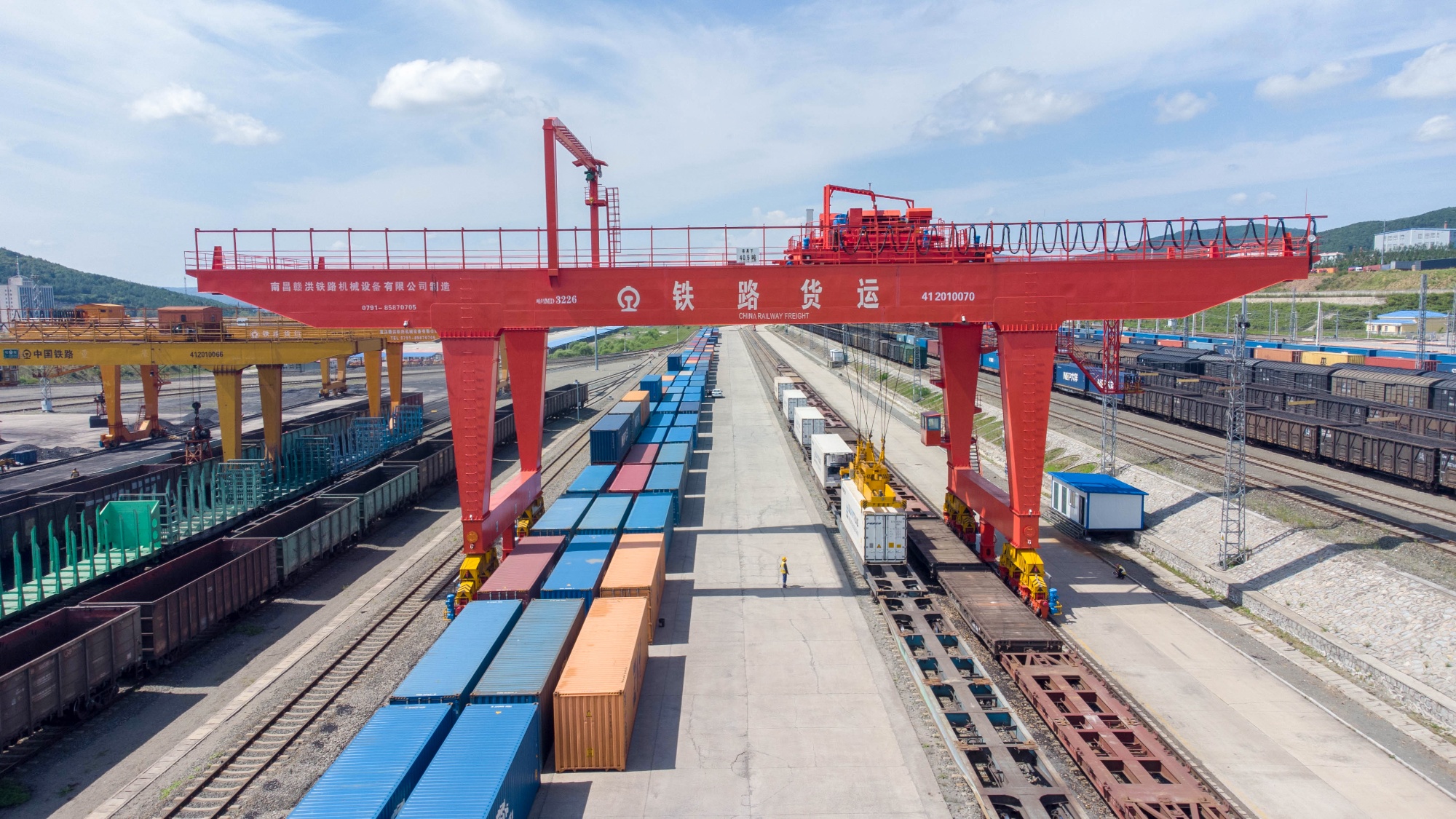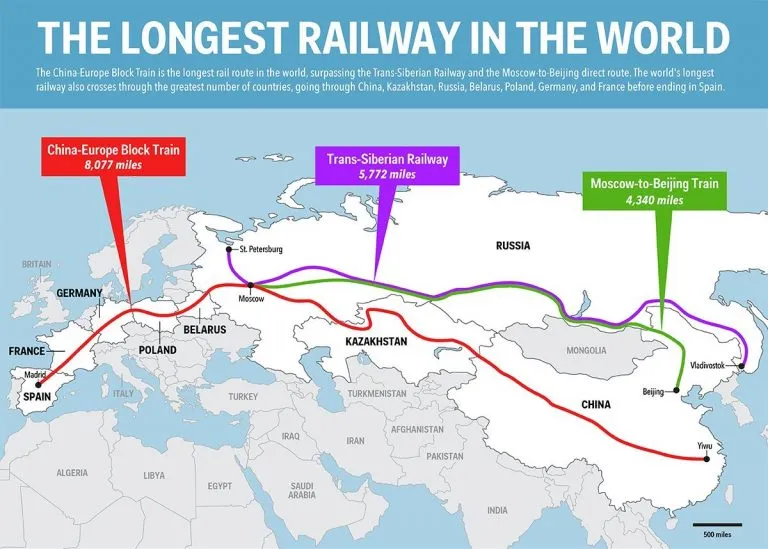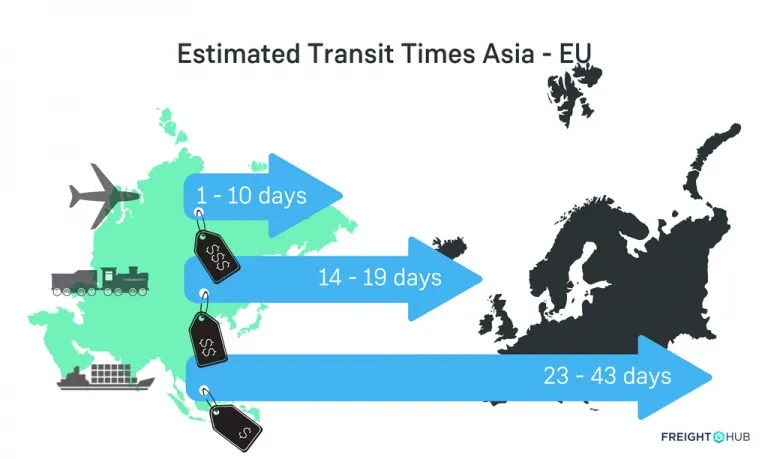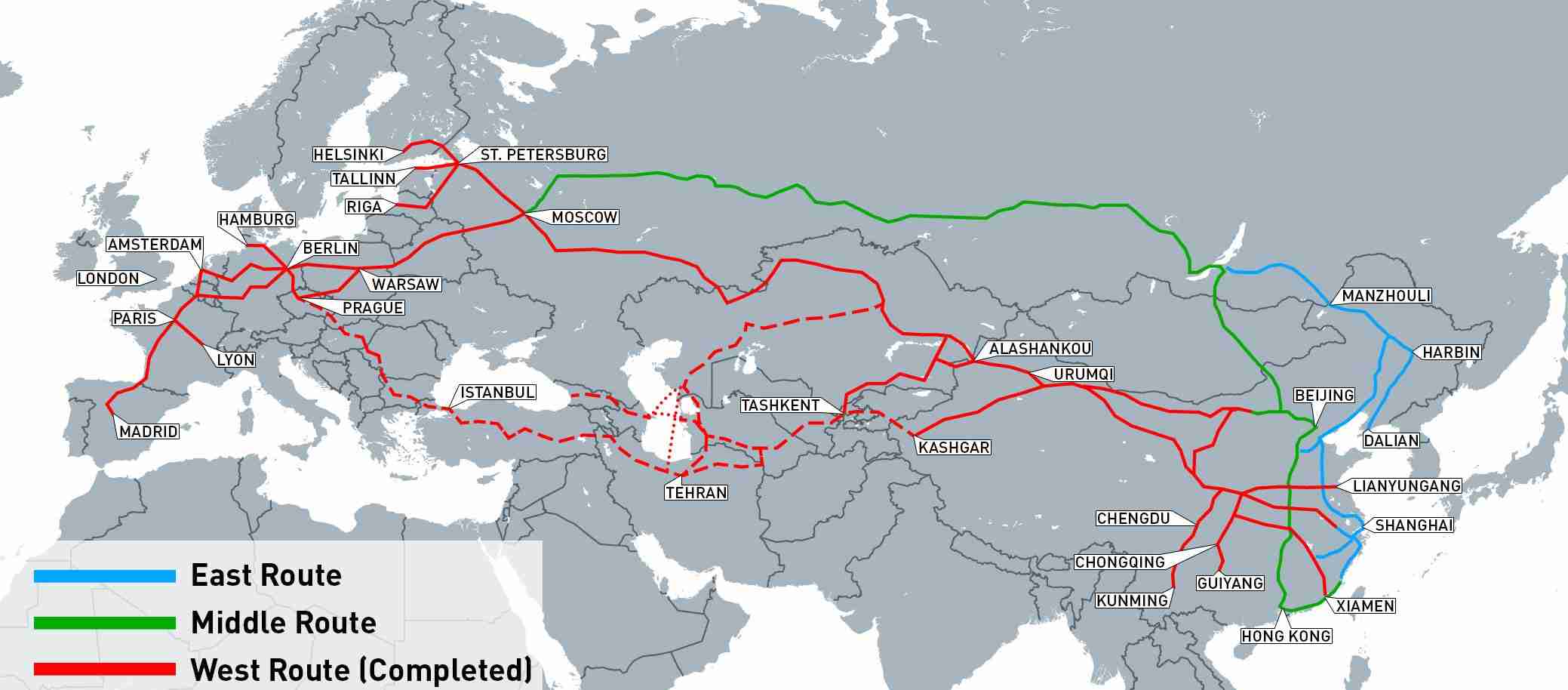Rail Freight Services
As The "Belt And Road" Initiative Continues To Grow, Railway Freight From China To Europe Has Emerged As A Popular Logistics Solution For Many Businesses. This Transportation Mode Strikes A Balance Between Efficiency, Cost, And Environmental Sustainability, Serving As A Middle Ground Between Sea And Air Freight.
This mode of transportation is perfectly suited to high-value industrial products such as vehicles, electronics and computer equipment, as well as promotional and seasonal products that must reach their final destination as quickly as possible.
RAIL FREIGHT: TRANSIT TIME
As an example:
from China to Lyon (France): 14 ~ 17 days
from China to Brussels (Belgium): 12 ~ 14 days
from China to London (UK): 18-20 days
RAIL FREIGHT FROM CHINA THROUGHOUT EUROPE
In recent years, China Railway has shipped freight through the famous Silk Road railway that connects 12,000 kilometers of track via the Trans-Siberian Railway.
An exciting project has just been set up: the first train from Yiwu to London (Barking in East London). He left on the 1st of January and arrived at destination on the 18th of January, which represents an average transit time of 18 days to get to London, more than the 15 days to get to Lyon. As a reminder, keep in mind that a container needs at least 30 days to reach the French ports.
This new service which is offered both for importers and exporters allows to ship to and from China in a fast and cost-effective way.
Note PRESOU: This service represents a potential direct saving of 50% compared to an importation from China by air freight. It represents also a time saving of 12 to 14 days compared to sea freight.
APART FROM LONDON, HERE ARE SOME OTHER EUROPEAN ROUTES / TRANSIT TIMES
There are two key rail links / routes: the first one starts in the north of China and connects with the famous Trans-Siberian (Russia), the second goes west through Kazakhstan before catching up with the Trans-Siberian Railway in Yekaterinburg, which is a key junction for rail freight in the Western part. In addition, these routes provide logistics solutions for the shipment of oversized objects (also called Project Cargo).
Here are some examples:
from China to Warsaw (Poland): ~ 12 days
from China to Hamburg (Germany): ~ 14 days
from China to London (United Kingdom): 16 ~ 18 days
from China to Moscow (Russia): ~ 12 days
Presou Logistics is proud to offer these kinds of services, enabling you to save time, money and troubles.
from CHINE to EUROPE: The longest railway in the world !
1) TIME AND COST SAVINGS
The cost of rail freight from/to China is potentially 50% cheaper than air cargo for the same trip. The transit time is 45% to 50% shorter, as compared to sea freight transport.
2) QUICKER CUSTOMS PROCEDURES
Customs declaration and inspection can be proceeded much more quickly than in the case of air freight or traditional sea freight. This customs service is available in the form of a full service 24/7, handled by our team present in China.
3) FLEXIBLE AND MULTIPLE SERVICES
A wide variety of goods is accepted for transportation and the services offered include: door-to-door deliveries, FCL and LCL, classic and dangerous goods.
Not a boat, not an airplane, but a train. The first freight train from China to the United Kingdom is now running. This new route of silk used by the intercontinental train is a new means of transport between the two continents and offers many advantages.
The main benefits of this option is its short delivery time and obviously the lower costs it offers. Indeed, the delays provided by rail freight are way shorter than sea freight and less expensive than air transport.
AN ALTERNATIVE TO AIR AND SEA FREIGHT
In recent years, the rail link between France and China has become a wise choice for customers concerned about delays and costs. As China’s economic power keeps on increasing, some French companies have decided to implement their production facilities there, benefiting from the booming Chinese market – this is why there is a high demand for railway freight.
Railway Freight is a perfect option for customers who need to deliver components and industrial products from France, Switzerland or Belgium to China, and vice versa. In addition, the two railways present on the Eurasian Land Bridge serve destinations in Russia, Kazakhstan and Mongolia.
The continued expansion of the rail network in China and the further simplification of customs procedures reinforce the importance of a direct rail link, as trade between Europe and China is growing.
CHARACTERISTICS OF RAILWAY FREIGHT
- Routes from China – Europe, China – Russia, as well as Germany – Japan and Germany – South Korea via Zhengzhou are operated in both direction
- So the cost of rail transportation is 50% lower than air freight and the transit time is 50% shorter than ocean freight
- The shipping cost for EXW to DDU China – Germany (Europe) and small LCL (1-4cbm) are more or less the same as sea freight
- Customs clearance is available 24/7!
- Door to door service & distribution network in Europe and China
- Container types: 20’GP, 20’HQ, 40’GP, 40’HQ, 45’GP, 45 ‘refrigerated container, clothing suspension container, open container
- To safe, stable, non-stop, fast
Currently, four weekly container train services from Duisburg and three weekly services from Hamburg serve China, in addition to the regular services from Wackersdorf and Leipzig-Wahren.
The new service from Duisburg crosses Poland, Belarus, Russia and Kazakhstan to the Chinese city of Chongqing, one of the largest industrial centers in the country located in Sichuan Province, offering excellent connections.
Freight trains cover a huge distance of 12,200 kilometers in 16 to 20 days, while traditional wagon trains take between 22 and 25 days to arrive at the final destination.
The train carries up to 100 TEUs (20 foot equivalent unit) and can carry 40-foot GPHC containers as well as standard PWHC containers. All containers are equipped with a GPS tracking system and an alarm function.
Contact us: Contact Presou Logistics and let us know your shipping requirements, including details such as cargo type, weight, volume and destination.
Quotation: We will provide you with a detailed quotation for your shipment, listing all relevant costs, including basic freight, fuel surcharges, customs clearance fees, insurance and any other additional service charges.
Documentation: Once you agree to the quotation, you will need to provide us with the necessary documents. This may include commercial invoice, packing list and any other relevant documents, depending on the nature of the goods being shipped.
Booking confirmation: Once all documents are completed, we will book the goods and provide you with a booking confirmation and estimated shipping time.
Prepare the goods: Make sure the goods meet the shipping requirements, pack them well, and prepare relevant documents such as commercial invoice, packing list and other necessary customs documents.
Customs clearance: Before departure, export customs clearance procedures need to be completed. Make sure all documents are complete to avoid delays.
Shipping and tracking: We will arrange to pick up the goods (if door-to-door delivery service is included) and deliver them to the railway terminal. While the goods are in transit, we will provide you with a tracking number so that you can monitor the progress of the goods.
Customs clearance: After the goods arrive in Europe, they will be cleared for import. Make sure all necessary documents are provided. Pay the relevant import duties according to the regulations of the destination country.
Delivery: After completing customs clearance, the goods can be delivered by local logistics companies.
Strong capacity
Railway transportation can carry large-scale cargo transportation, and is especially suitable for long-distance transportation of heavy goods and bulk commodities (such as coal, ore, petroleum, chemical products, etc.). A single train car can transport dozens of tons of cargo, while a full freight train can carry thousands of tons.
Cost effective
Compared with air and road transportation, the cost of rail transportation is lower, especially when transporting large quantities of goods, the unit transportation cost is significantly reduced. Rail is a cost-effective option for long-distance transport.
Good transportation stability
Railway transportation is less affected by external factors such as weather and road conditions, so it has strong time stability and can deliver on time, ensuring the reliability of the supply chain. Especially in cases of bad weather or frequent traffic jams, rail transportation can effectively avoid these problems.
Environmentally friendly and low carbon
Compared with road and air transportation, railway transportation consumes less energy and produces less carbon emissions, making it a more environmentally friendly mode of transportation. As the world pays attention to carbon emissions and environmental protection, railway transportation plays an increasingly important role in sustainable logistics.
Wide range of applications
Railway transportation is not only suitable for heavy goods and bulk materials, but also can transport containers and bulk cargo to meet the needs of different industries. In addition, railway freight can also be combined with shipping, road transportation and other methods to form a multimodal transport system and achieve full logistics services.
Container international railway trains between China and Europe and countries along the “Belt and Road”. Its route can be divided into three main operating lines: the western channel, the middle channel and the eastern channel.
Western passage
The Western Corridor mainly exits from the central and western regions of my country through Alashankou (Horgos) and leads to European countries. The main routes include: Chongqing-Duisburg, Chengdu-Lodz
, Xi’an-Duisburg, Lanzhou-Hamburg and other lines, these lines not only promote economic and trade cooperation with countries and regions along the route, but also provide more opportunities for enterprises in western my country to export to Europe.
Middle channel
The Central Corridor mainly exits from North my country through Erenhot and leads to European countries. The main routes include: Zhengzhou-Hamburg, Shenyang-Europe. This route provides enterprises in the central and eastern regions with a new channel to Europe, and also promotes the construction of the China-Mongolia-Russia Economic Corridor.
Eastern Passage
The Eastern Passage mainly exits from the southeastern coastal areas of my country through Manzhouli (Suifenhe) and leads to European countries. The main routes include: Suzhou-Warsaw, Yiwu-Madrid: As an important part of the China-Europe freight train, this route runs through the New Silk Road Economic Belt. In addition, there are also eastern coastal cities such as Guangzhou, Qingdao, and Lianyungang passing through Manzhouli or Suifenhe. Outbound China-Europe train lines connect Russia, Europe and other countries and regions.
The price of China-Europe trains varies according to factors such as the type of goods, transportation distance, and transportation time. Generally speaking, rail transportation is relatively cheap and is particularly suitable for long-distance transportation of bulk goods.
20ft container: Generally, the rail freight for transporting a 20ft container from China to Europe is between US$4,000-6,000. This is a rough range, and the actual cost will vary depending on the route and type of goods.
40ft container: The freight for a 40ft container is around US$6,000-8,000, and the specific price also depends on the weight of the goods, the route, and the service requirements.
Basic freight
Basic freight refers to the fixed cost of railway transportation, including wagon fees, loading and unloading fees, etc. This is the most important cost part of railway transportation.
Surcharges
Surcharges include fuel surcharges, currency fluctuation surcharges, etc., which will be adjusted according to market fluctuations.
Customs clearance fees
The cost of customs clearance depends on the type of goods and the relevant regulations of the destination country. Including China’s export customs clearance fees and European destination country’s import customs clearance fees.
Cargo insurance premiums
Insurance costs in railway transportation are usually calculated based on the value of the goods. The insurance costs of high-value goods are relatively high.
Other costs
Other costs may include transit costs, storage fees, etc. of goods. These costs vary depending on the specific operational needs of the goods.
The transportation time of China-Europe trains varies according to the route and the distance between the starting point and the end point. Generally speaking, the transportation time from China to Europe is between 15 and 20 days. In actual operation, due to the existence of track changes, inspections and other links, the actual transportation time may be slightly longer.
| Origin | Destination (Europe) | Approximate Transit Time |
|---|---|---|
| China | Germany | 16-18 days |
| China | Poland | 17-19 days |
| China | France | 18-20 days |
| China | Spain | 18-21 days |
| China | Hungary | 17-20 days |
| China | Italy | 16-19 days |
| China | Austria | 16-19 days |
| China | Belgium | 16-19 days |
| China | Czech | 16-19 days |
Transportation distance and route selection
Distance length: The length of the China-Europe railway transportation route directly affects freight and time. The distance between different starting points and end points as well as the operating route of the train will directly affect freight and time. The farther the distance and the more countries it passes through, the higher the transportation cost. The longer the time
Container type
The size and type of container also have a significant impact on freight rates. Although the freight of 40-foot containers is higher, the cost of a single piece of cargo is lower, making it suitable for bulk commodity transportation. 20-foot containers are suitable for small quantities of goods, and the freight is relatively low. Calculate.
Cargo type
Different types of goods have different requirements when transporting them. For example, dangerous goods, perishables or high-value goods, large goods require special loading equipment and require special handling, which increases the complexity and cost of transportation and may extend the transportation time.
Seasonal fluctuations in shipping costs
Railway transportation between China and Europe is also affected by seasonal factors. Generally speaking, during peak seasons (such as China’s export peak or European holidays), demand for China-Europe railway transportation increases, freight rates rise, and trains may extend transportation time due to backlog of goods.
Climatic conditions
In winter, especially in cold regions such as Siberia, rail transportation can be affected by extreme weather, resulting in longer transportation times. The weather is more stable in the spring and summer, and so are the times and costs.
Customs fees and insurance
Various costs involved in the transportation of goods, such as customs clearance fees, cargo insurance, etc., will be included in the total freight. Different types of goods and destination countries have different customs regulations and customs clearance fees.
Packaging requirements
Ensure that the goods are properly packaged to withstand vibration and impact during transportation. Use moisture-proof materials to prevent moisture or damage to the goods.
Document preparation
Fill out the transportation documents accurately and ensure that the information on the transportation documents, invoices and packing lists is accurate to avoid customs clearance and transportation delays. Prepare relevant licenses and compliance documents according to the type of goods.
Cargo classification
Special cargo handling: such as dangerous goods, perishable goods, etc., need to be specially handled in accordance with relevant regulations and follow the corresponding transportation regulations. Ensure that the weight and volume of the goods meet the standards for railway transportation.
Schedule
Railway transportation takes a long time, and transportation plans need to be arranged in advance to ensure on-time delivery. Use the logistics management system or the tracking tools provided to monitor the status of cargo transportation in real time and deal with emergencies in a timely manner
Cost budget
Carefully estimate various expenses before transportation, including freight, insurance, loading and unloading fees, etc., to avoid unexpected expenses. Choose a cost-effective transportation plan.
Insurance
Cargo insurance, insure the goods to prevent possible losses and risks during transportation.
Customs clearance process
Be familiar with customs clearance requirements: Understand the customs clearance requirements of the destination country in advance and ensure that all documents are complete to avoid customs clearance delays. If necessary, consider entrusting a professional freight forwarder to handle customs clearance matters.
 English
English 简体中文
简体中文 繁體中文
繁體中文 Afrikaans
Afrikaans አማርኛ
አማርኛ Español
Español العربية
العربية Français
Français Dansk
Dansk Български
Български Беларуская мова
Беларуская мова বাংলা
বাংলা Português
Português Русский
Русский Afsoomaali
Afsoomaali فارسی
فارسی Türkçe
Türkçe كوردی
كوردی Deutsch
Deutsch 日本語
日本語 ไทย
ไทย Tiếng Việt
Tiếng Việt Italiano
Italiano עִבְרִית
עִבְרִית 한국어
한국어 Română
Română Nederlands
Nederlands Bahasa Indonesia
Bahasa Indonesia Shona
Shona





